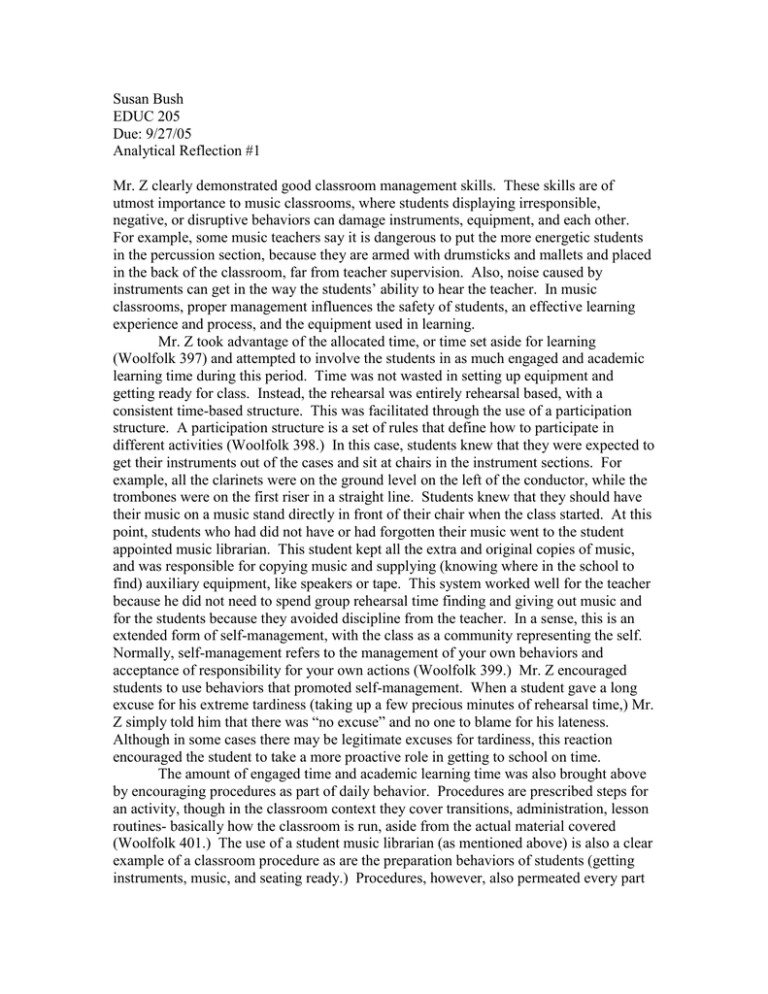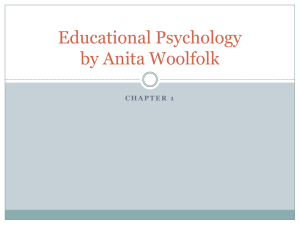Susan Bush EDUC 205 Due: 9/27/05 Analytical Reflection #1
advertisement

Susan Bush EDUC 205 Due: 9/27/05 Analytical Reflection #1 Mr. Z clearly demonstrated good classroom management skills. These skills are of utmost importance to music classrooms, where students displaying irresponsible, negative, or disruptive behaviors can damage instruments, equipment, and each other. For example, some music teachers say it is dangerous to put the more energetic students in the percussion section, because they are armed with drumsticks and mallets and placed in the back of the classroom, far from teacher supervision. Also, noise caused by instruments can get in the way the students’ ability to hear the teacher. In music classrooms, proper management influences the safety of students, an effective learning experience and process, and the equipment used in learning. Mr. Z took advantage of the allocated time, or time set aside for learning (Woolfolk 397) and attempted to involve the students in as much engaged and academic learning time during this period. Time was not wasted in setting up equipment and getting ready for class. Instead, the rehearsal was entirely rehearsal based, with a consistent time-based structure. This was facilitated through the use of a participation structure. A participation structure is a set of rules that define how to participate in different activities (Woolfolk 398.) In this case, students knew that they were expected to get their instruments out of the cases and sit at chairs in the instrument sections. For example, all the clarinets were on the ground level on the left of the conductor, while the trombones were on the first riser in a straight line. Students knew that they should have their music on a music stand directly in front of their chair when the class started. At this point, students who had did not have or had forgotten their music went to the student appointed music librarian. This student kept all the extra and original copies of music, and was responsible for copying music and supplying (knowing where in the school to find) auxiliary equipment, like speakers or tape. This system worked well for the teacher because he did not need to spend group rehearsal time finding and giving out music and for the students because they avoided discipline from the teacher. In a sense, this is an extended form of self-management, with the class as a community representing the self. Normally, self-management refers to the management of your own behaviors and acceptance of responsibility for your own actions (Woolfolk 399.) Mr. Z encouraged students to use behaviors that promoted self-management. When a student gave a long excuse for his extreme tardiness (taking up a few precious minutes of rehearsal time,) Mr. Z simply told him that there was “no excuse” and no one to blame for his lateness. Although in some cases there may be legitimate excuses for tardiness, this reaction encouraged the student to take a more proactive role in getting to school on time. The amount of engaged time and academic learning time was also brought above by encouraging procedures as part of daily behavior. Procedures are prescribed steps for an activity, though in the classroom context they cover transitions, administration, lesson routines- basically how the classroom is run, aside from the actual material covered (Woolfolk 401.) The use of a student music librarian (as mentioned above) is also a clear example of a classroom procedure as are the preparation behaviors of students (getting instruments, music, and seating ready.) Procedures, however, also permeated every part of the lessons. First students started with scales. They were aware that they would not need their music, so they just got their instruments ready. Each day, Mr. Z would ask students to give the name and number of sharps or flats in a given scale. Students knew that this information would be asked of them eventually, so they had more impetus to take an active role in learning it (and were given opportunities to learn it every day.) There were also examples of scaffolding. Although scaffolding is a form of assisted learning, or guiding student participation through providing prompts and questions (Woolfolk 51,) it is here a part of the classroom procedure. Mr. Z provided questions and encouraged students each morning to follow the examples of previous students (“if she said G major has one sharp, how many does D major have?”) In this way scaffolding became a part of the classroom procedure. After scales, the students knew that they would tune. This meant that each individual in the section would play a concert B flat when the teacher pointed to him. Students were ready for this process, so it went remarkably smoothly. The teacher would instruct the students on their tuning issues (“you’re too flat, push in (the tuning slide)”) and then listen again to the individual. This process not only ensures good tuning, but also gives the teacher a chance to hear tone production and problems progressively in each student. This kind of alternative assessment can be very helpful when students primarily play in a large group setting. The students were ready for warm-up exercises, then work on the piece in the classroom, then out to the field to practice marching and playing. Rules (Woolfolk 402) were not clearly apparent in the classroom, but it seemed that procedures replaced them. Students knew how to do things correctly (keep your instrument in proper rest position while we move around), instead of just remembering a “don’t” rule (don’t step on your instrument.) Unfortunately, I was not present for the first week of class, but I would assume that these procedures and behaviors were clearly laid out for the students and practiced, as in the description of Woolfolk’s ‘effective manager for secondary students’ (Woolfolk 407.) I knew one music teacher who actually asked his students to practice coming into the classroom quietly five times on the first day of school! It might seem tedious, but his procedures were very clear to the students. It seems that students are more receptive to this kind of respectful, organized classroom. On the subject of classroom management, I did feel that Mr. Z sometimes presented a hostile disciplinary image (Woolfolk 418.) He used “you” when addressing negative concerns with (condemning) students. The teacher did use questions sometimes, as though he was using a passive style. In one case, student A had forgotten her flute at home, so she used another student’s instrument from the instrument cabinets. When Mr. Z realized this, he asked, “Is that your flute? Why are you using someone else’s flute? You need to bring yours from home.” Initially, this response starts with asking the student if she is doing what he thinks she is. This is essentially passive, because he is asking the student if she has done wrong (Woolfolk 418.) The next part is an assertive response because the students were clearly aware that they were expected to bring their own instruments. These written words do not convey the sense of mild hostility in the exchange. The student was clearly being threatened (though that is a very strong word) with punishment. The teacher was sometimes shouting at the students for irresponsible or thoughtless behaviors. Students did not seem to react well to this kind of discipline. They looked hostile and angry after being singled out and shouted out. Proper discipline should not create a negative learning environment. After all, the point is to teach the students, not punish them. In some cases, Mr. Z used unorthodox and highly successful disciplinary techniques. When one student was resting his saxophone and arm on his chair and slouching during rehearsal, the teacher first reprimanded him. Next he asked the student to remove his chair and stand for the remainder of the lesson. This method worked amazingly well because the student was too proud to be caught trying to sit down by his peers. At one point he tried to lean on his chair and his classmate teased him about being lazy. Immediately he stood up straight. This kind of discipline is, in my opinion, the most effective. Students react well to logical consequences to their actions, rather than arbitrary punishments. It seems quite counteractive to give students punishments that require them to be less active, still, or to do some worthless activity. At the same time, we should not demean activities like homework, practicing, or picking up trash by treating them as punishment. Consequences should be logical and should support the proper standards for behavior. At a music camp where I worked, the boys were awake at five am and began engaging in noisy, unsupervised, and destructive behaviors. As a consequence, they were taken on a mandatory hike and dodge-ball game during recreation to help them get rid of their energy and sleep more soundly. Although this kind of consequence does not relate directly to schools, students can be given closelyrelated logical consequences like the one observed in Mr. Z’s classroom. Another interesting situation arose when Mr. Z made a mistake and reprimanded the class for an action that was his fault. When the students pointed out that he was shouting at them for no reason, he shouted back “don’t you know you’re supposed to be reading my mind not listening to what I say?” The students froze and took a minute to see that he was kidding. This way of making fun of his own inappropriate discipline lightened up the mood without an awkward moment with the teacher admitting his mistake. He acknowledged it without stopping the flow of the class. It was particularly funny because one student decided to jump on the opportunity and teased Mr. Z about his hair being so copious that it obscured his extra-sensory perception. The student and teacher exchanged banter, which lightened the mood but did not pull the class off topic and was not disrespectful. Mr. Z’s classroom management effectively involved him in less disciplinary behaviors and more engaged learning time. The classroom procedures in particular set up the classroom and students to self-manage. Combined with the teacher’s withitness, or awareness of everything happening in the classroom, and the use of group focus (keeping all students involved in the activities), students were kept on task (Woolfolk 409.) The small size of the class and the early morning schedule also contributed to an easily manageable class. It is, however, of utmost importance that procedures are laid out early in the school year to ensure a sense of mutual respect, organization, and efficiency.

